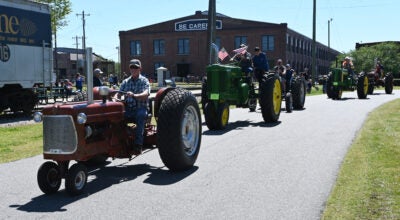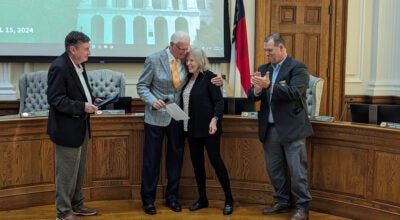Published 12:00 am Sunday, September 8, 2013
SPENCER — On the surface, they’re just toys.
Wood and plastic resin, porcelain, cloth and silk thread.
But no matter how many hundreds, or thousands, of similar items were made, you can bet that one of them was the toy, as far as some boy or girl was concerned.
That this one particular doll, circus animal, stagecoach or what-have-you was some boy’s or girl’s prized possession, somewhere back through the years.
Beth Nance, one of the founders of the Spencer Doll and Toy Museum, says that this magic, and the stories people remember about their toys, are among the reasons she loves hearing from visitors and collectors.
In nearly 14 months since the museum opened at 104 4th St. in Spencer, across from the N.C. Transportation Museum, Nance said she’s gotten phone calls and emails from around the world.
Nance said she gets those calls all the time. “I can’t even tell you the number,” she said.
They include people trying to get information about exhibits, as well as some who want to loan, sell or donate their own collections.
Two current exhibits at the museum are the result of those contacts: a display of century-old dolls and dollhouses from Germany, and a collection of Ginny dolls from a woman in Texas.
In the 1940s and 1950s, a decade before Barbie was introduced, the dolls made by the Vogue Co. of Sommerville, Mass., were popular girls’ toys.
“They were just huge in the fifties and sixties, and could be purchased at your local dime store,” Nance said.
The babyfaced dolls in the museum’s display cases feature Ginny in a variety of roles: dressed up for a party, in an evening gown, on her way to school with books and reading glasses.
There’s even a Ginny doll dressed as a nun.
Nance said the Ginny collection came to Spencer because of a call from a Texas collector, Gael Elliston, who Nance said found the museum’s website.
Today, Ginny dolls are still available, Nance said, but are marketed to toy collectors and aren’t really designed for play.
But, although there are some later dolls among those Elliston sent to Spencer, most of the ones in the collection date back 40 to 50 years.
For years, Wayne and Helen Thomas, of Huntersville, collected Schoenhut dolls.
Popular in the northeastern U.S., the dolls were first made by German immigrant Albert Schoenhut in 1911.
Throughout the early 20th century, many of the dolls were hand-carved from wood that was pressure-treated, creating a durable and realistic face.
Saturday, the Thomases were in town for a doll collectors’ show. They spent the afternoon at the museum in Spencer.
They are members of the museum’s board of directors, and regularly display some of the toys and dolls in their collection.
Wayne Thomas said his fascination with Schoenhut toys came when he found a carefully-carved clown doll in an auction, years ago.
He said he was impressed at the artistry displayed by Schoenhut, who came from a family of German toymakers.
“Originally, they were all carved by hand, before they started using molds,” Wayne Thomas said.
“And they were copies of (Albert Schoenhut’s) family, of his children,” Helen Thomas added.
Sitting near a display case full of Schoenhut dolls in a variety of costumes — a nurse, a boy in casual clothes, another in traditional German clothing — the Thomases tell about how they amassed a collection of hundreds of Schoenhut toys.
Their pride and joy is the circus collection, which stretches nearly 20 feet across display cases in the museum.
Through the 1920’s and 1930’s, he said, the Schoenhut company made a variety of safari-themed and circus-themed toy sets.
The Humpty Dumpty Circus line of toys is colorful and intricate, even by today’s standards.
There are lions, hippos, camels, elephants and horses.
Schoenhut also made a circus band and its wagon, “but that’s very rare and very expensive, so I don’t think you’ll ever get to see that one,” Wayne said.
And there’s even a chariot, pulled by a donkey, which he said is “very rare.”
Schoenhut also sold lithographed cloth circus tents, as well as many accessories.
Finding them is difficult today, the Nances said, because they were made of materials that were easy to manufacture at the time: plastic resin, cloth, even cardboard.
Wayne said he believes the circus chariot is rare because it was one of the cardboard toys. “It probably got destroyed,” he said. “We found one sort of by accident, in an (online) auction.”
Part of the fun for the Thomases, as with many die-hard collectors, is telling the stories of finding rare pieces in estate auctions, or online.
Nance did not wish to give a dollar value for the Schoenhut toys currently on display at the museum.
However, Schoenhut toys similar to those on display are currently offered online for hundreds of dollars apiece.
The Thomases are also showcasing their French fashion dolls, which Helen called “the Barbie doll of the 1800’s.”
These dolls are notable more for their clothes and accessories than for the dolls themselves.
Helen Thomas said that, just as some dolls today come with storybooks or are used for teaching, the French fashion dolls also had an educational purpose.
They were used to teach girls of wealthy families about the clothing, attitudes and activities that would be expected of them as they got older.
“How to dress for the morning, how to dress for tea, how to dress in general,” Helen Nance said. “It was part of the girl’s social education.”
And, just as some dolls today come with high-dollar accessories, so it was in Paris.
Helen Thomas said that shops along the fashionable Champs-Elysées Avenue sold brand-name doll accessories modeled after those that Parisian women could buy – including, she said, designer Louis Vutton.
“The little girl had to have the same accessories the grown-ups had!” Helen said.
It’s a situation that one museum guest could relate to.
Ashley Gough, 10, was there with her mother and grandmother. They’d come by after visiting the collectors’ meeting in Salisbury.
“The American Girl dolls first got me interested in history,” said Gough, who brought two dolls from her own collection – named Saige and McKenna – into the museum as she browsed.
When Nance explained to her how girls used to make their own doll clothes, she told her mother, Linda, that she wanted to learn how.
“The (American Girl) doll accessories are so expensive!” Ashley said. “They hardly give you anything with the doll.”
Nance said that, whether it’s a collection of intricate, handmade German doll houses — complete with furniture, including tiny steel and porcelain kitchenware – or Barbies from recent decades, she enjoys keeping people’s memories alive, and sharing a love of toys and dolls with young and old alike.
She said she’s amazed by the detail and the craftsmanship, but also by the stories that those dolls and toys can uncover … hidden by the years.
Contact Hugh Fisher via the editor’s desk at 704-797-4244.




